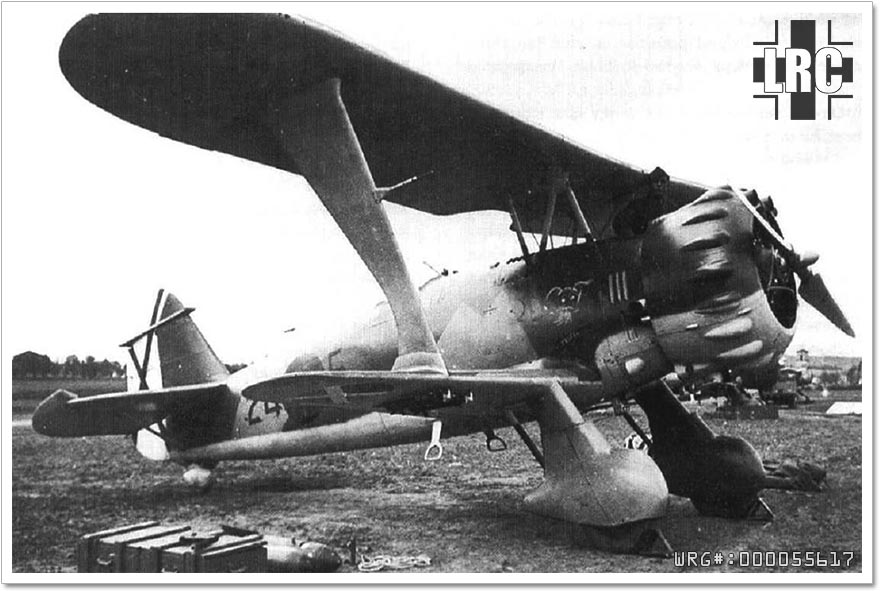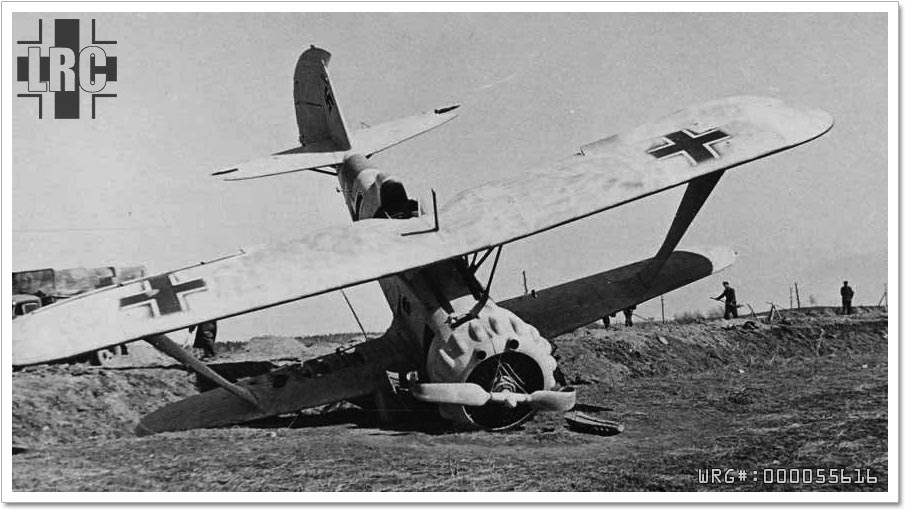Prior to World War II
A small pre-production batch of Hs 123A-0s was completed in 1936 for service evaluation by the Luftwaffe. This
initial group was followed by the slightly modified Hs 123A-1 series, the first production examples. The
service aircraft flew with an armoured headrest and fairing in place (a canopy was tested in the Hs 123V6) as
well as removable main wheel spats and a faired tailwheel. The main weapon load of four SC50 110 lb (50 kg)
bombs could be carried in lower wing racks along with an additional SC250 550 lb (250 kg) bomb mounted on a
"crutch" beneath the fuselage. The usual configuration was to install an auxiliary fuel "drop" tank at this
station that was jettisoned in emergencies. Two 7.92 mm MG 17 machine guns were mounted in the
nose synchronized to fire through the propeller arc.
 Henschel Hs 123 with the Condor Legion
Henschel Hs 123 with the Condor Legion
The aircraft entered service at StG 162 in autumn 1936. Its career as a dive bomber was cut short when the
unit received its first Ju 87A the next year. Remaining Hs 123s were incorporated into the temporary
Fliegergeschwader 100 at the time of the Munich Crisis. The Geschwader (wing) had been created as an
emergency measure, equipped with obsolete aircraft and tasked with the ground attack role. With the signing
of the Munich agreement, the crisis was over and the Geschwader was disbanded, the Gruppen being
transferred to other established units. By 1939, despite its success in Spain, the Luftwaffe considered
the Hs 123 obsolete and the Schlachtgeschwader (close-support wings) had been disbanded with only one
Gruppe, II.(Schl)/LG2 still equipped with the Hs 123.
Spanish Civil War
During the same time, at the request of Oberst (later Generalfeldmarschall) Wolfram Freiherr von Richthofen,
chief of staff of the Legion Kondor, five aircraft had been deployed to Spain as a part of the Condor Legion,
intended to be used as tactical bombers.
 Henschel Hs 123A-1 with the Condor Legion.
Henschel Hs 123A-1 with the Condor Legion.
In their intended role, the Hs 123s proved to be somewhat of a failure, hampered by their small bomb capacity
and short range. Instead, the Hs 123s based in Seville were used for ground support, a role in which their
range was not such a detriment, and where the ability to accurately place munitions was more important than
carrying a large load. The combat evaluation of the Hs 123 demonstrated a remarkable resiliency in
close-support missions, proving able to absorb a great deal of punishment including direct hits on the
airframe and engine. The Nationalists in Spain were suitably impressed with the Hs 123 under battle
conditions, purchasing the entire evaluation flight and ordering an additional 11 aircraft from Germany.
The Spanish Hs 123s were known as "Angelito" (dear angel or little angel) and at least one Hs 123 was in
service with the Spanish Air Force (Ejército del Aire) after 1945.
Second Sino-Japanese War Twelve Hs 123s were also exported to China, where they were used extensively as dive
bombers against Japanese warships along the Yangtze River, especially in 1938.
World War II (service from Poland to Greece)
At the outbreak of hostilities, the surviving 39 Hs 123s assigned to II. (Schl)/LG 2, were committed to action
in the Polish Campaign. This single unit proved to be particularly effective. Screaming over the heads of
enemy troops, the Hs 123s delivered their bombs with devastating accuracy. A frightening aspect of an Hs 123
attack was the staccato noise of its engine that a pilot could manipulate by changing rpm to create
"gunfire-like" bursts. The Hs 123 proved rugged and able to take a lot of damage and still keep on flying.
Operating from primitive bases close to the front lines, ground crews considered the type reliable in
field conditions, being easy to maintain.
The Polish campaign was a success for an aircraft considered obsolete by the Luftwaffe high command. Within a
year, the Hs 123 was again in action in the blitzkrieg attacks through the Netherlands and France. General
Guderian was continually impressed by the quick turnaround time offered by II.(Schl)/LG 2. Often positioned
as the Luftwaffe's most-forward based combat unit, the Hs 123 flew more missions per day than other units,
and again proved their worth in the close-support role. With Ju 87s still being used as tactical bombers
rather than true ground support aircraft and with no other aircraft capable of this mission in the Luftwaffe
arsenal, the Hs 123 was destined to continue in service for some time more, although numbers were
constantly being reduced by attrition.
 Henschel Hs 123.
Henschel Hs 123.
The Hs 123 was not employed in the subsequent Battle of Britain as the English Channel proved a formidable
obstacle for the short-ranged aircraft. The sole operator, II.(Schl)/LG 2 went back to Germany to re-equip
with the Messerschmitt Bf 109E fighter bomber (Jabo) variant. The Bf 109E fighter bomber was not capable of
carrying any more bombs than the Hs 123. It did however, have a greater range and was far more capable of
defending itself. On the downside were the notoriously tricky taxiing, ground handling and takeoff/landing
characteristics, especially exacerbated with a bomb load.
At the beginning of the Balkans Campaign, the 32 examples of the Hs 123 that had been retired after the fall
of France were taken back into service to equip 10.(Schl)/LG 2. The aircraft performed well enough to warrant
its use in Operation Barbarossa.
World War II (Eastern Front)
At the start of Operation Barbarossa, the single Gruppe of the Luftwaffe that was dedicated to ground support
was II.(Schl)/LG 2, operating 38 Bf 109Es and 22 Hs 123s. In service use on the Eastern Front, the remaining
aircraft had been "field" modified with the main wheel spats removed, additional armour and extra equipment
fitted as well as mounting extra machine guns and even cannons in under-wing housings.
 Crashed Henschel Hs 123 with winter camo on the Eastern Front.
Crashed Henschel Hs 123 with winter camo on the Eastern Front.
Some volunteers of Escuadrilla Azul (15 Spanische Staffel/VIII Fliegerkorps) of JG-27 detached in Luftflotte 2
managed Hs 123s in collaboration of II.(Schl.)/LG 2 units for ground strikes along your propers Bf 109E-7/B
fighter-bombers during 1941-42 period.
During the initial drive, the unit participated in action along the central and northern parts of the front,
including a brief time in support of the fighting around Leningrad, and participating in the battles for
Bryansk and Vyazma. The first weeks revealed problems associated with using the Bf 109E which was plagued by
undercarriage and engine problems in the fighter-bomber role. Its liquid-cooled inline engine was also more
vulnerable to small arms fire than the Hs 123's radial.
 Henschel Hs 123 in winter camoflage.
Henschel Hs 123 in winter camoflage.
The winter brought hardship to all German forces in Russia, and the pilots in the open cockpits of the Henschels
suffered accordingly. Despite this, they took part in the Battle of Moscow. In January, the unit was
re-designated as the first dedicated ground attack Geschwader, SchlG 1. The Hs 123 became a part of
7./SchlG 1.
This "new" unit participated in operations in Crimea in May 1942, after which it operated on the southern
sector for some time, participating in the Second Battle of Kharkov and going on to take part in the Battle of
Stalingrad. In the meantime, the small number of operational Hs 123 continued to slowly dwindle. Aircraft had
been salvaged from training schools and even derelict dumps all over Germany to replace losses. The aircraft
that had supposedly replaced the Hs 123, the Ju 87, also started to be assigned to ground support units,
leaving tactical bombing to newer aircraft.
The greatest tribute to the Hs 123 usefulness came in January 1943 when Generaloberst Wolfram Freiherr von
Richthofen, then commander-in-chief of Luftflotte 4, asked whether production of the Hs 123 could be restarted
because the Hs 123 performed well in a theater where mud, snow, rain and ice took a heavy toll on the
serviceability of more advanced aircraft. However, the Henschel factory had already dismantled all tools
and jigs in 1940.
 Henschel Hs 123 of SG.1
Henschel Hs 123 of SG.1
After taking part in the Battle of Kursk, SG 1 returned to Crimea, and there during late spring 1944, they
finally gave up the aircraft that had served all over Europe from Spain to Leningrad. 7./SG 1 traded its last
Hs 123s in mid-1944, for Ju 87s, a type that was to have replaced it back in 1937.
By 1945, the Hs 123s that remained serviceable were reassigned to secondary duties such as supply dropping and
glider towing.






 , 1979, Airlife Publishing Ltd., Shrewsbury
, 1979, Airlife Publishing Ltd., Shrewsbury , 1977, Salamander
Books Ltd., London
, 1977, Salamander
Books Ltd., London





